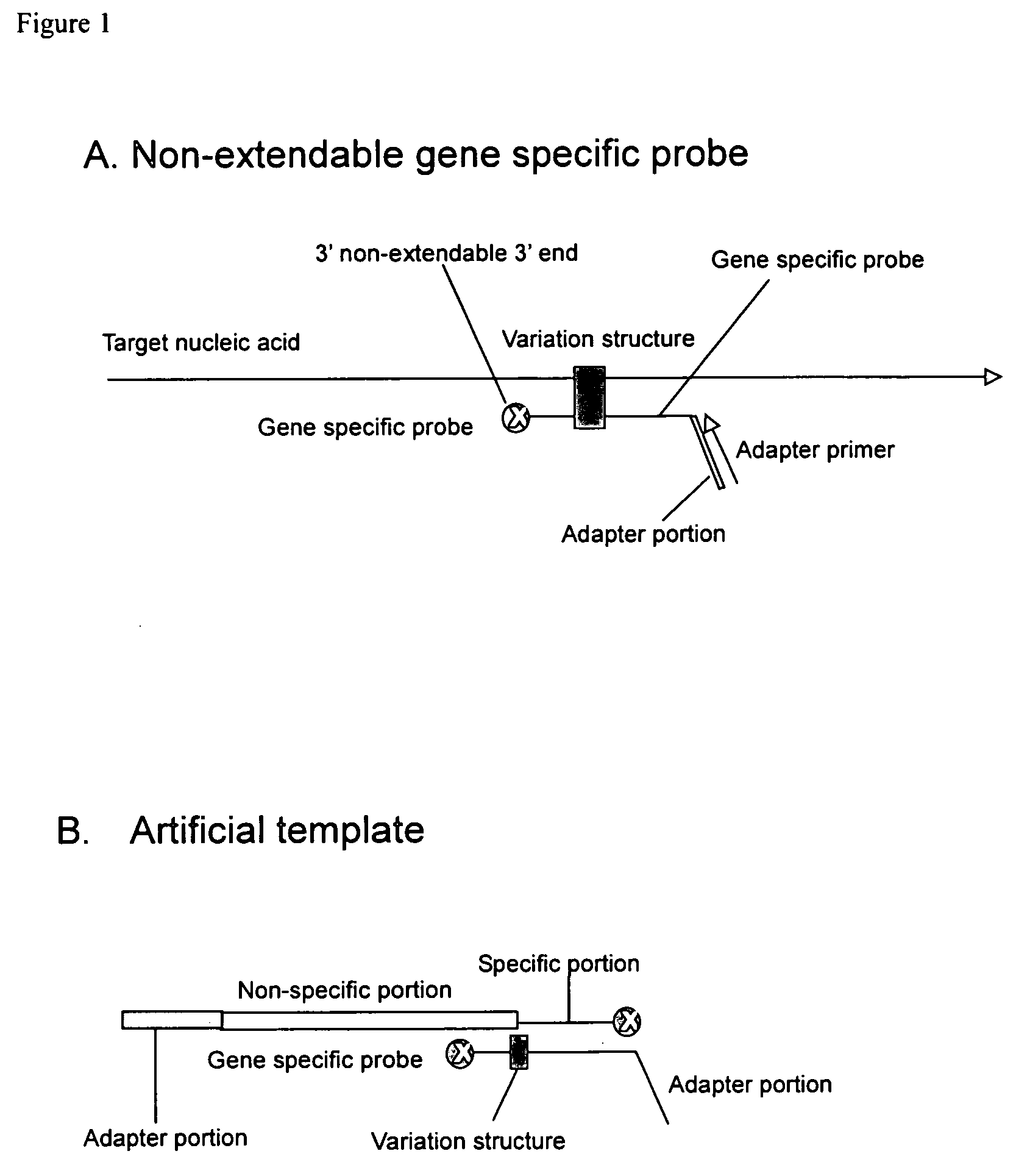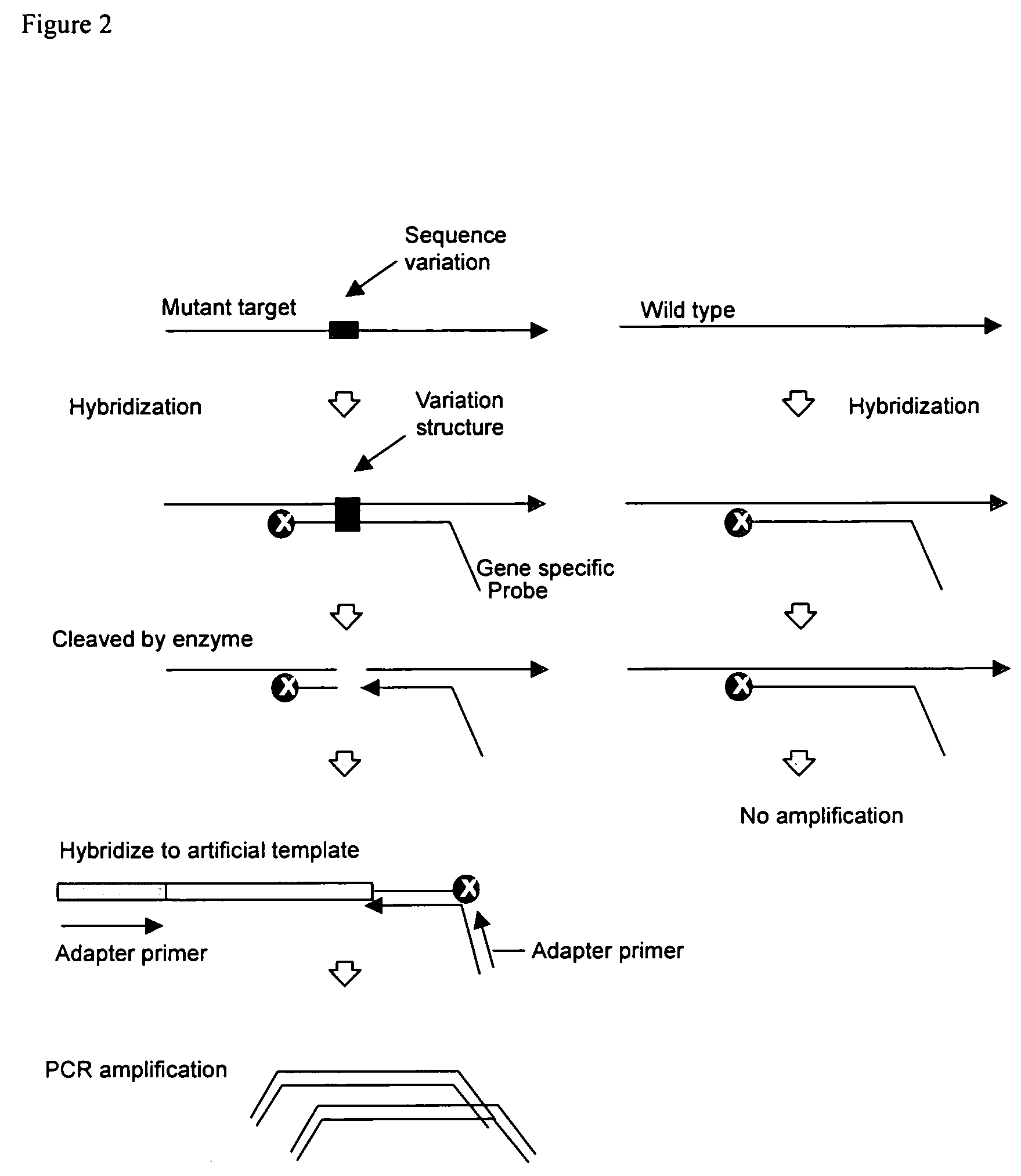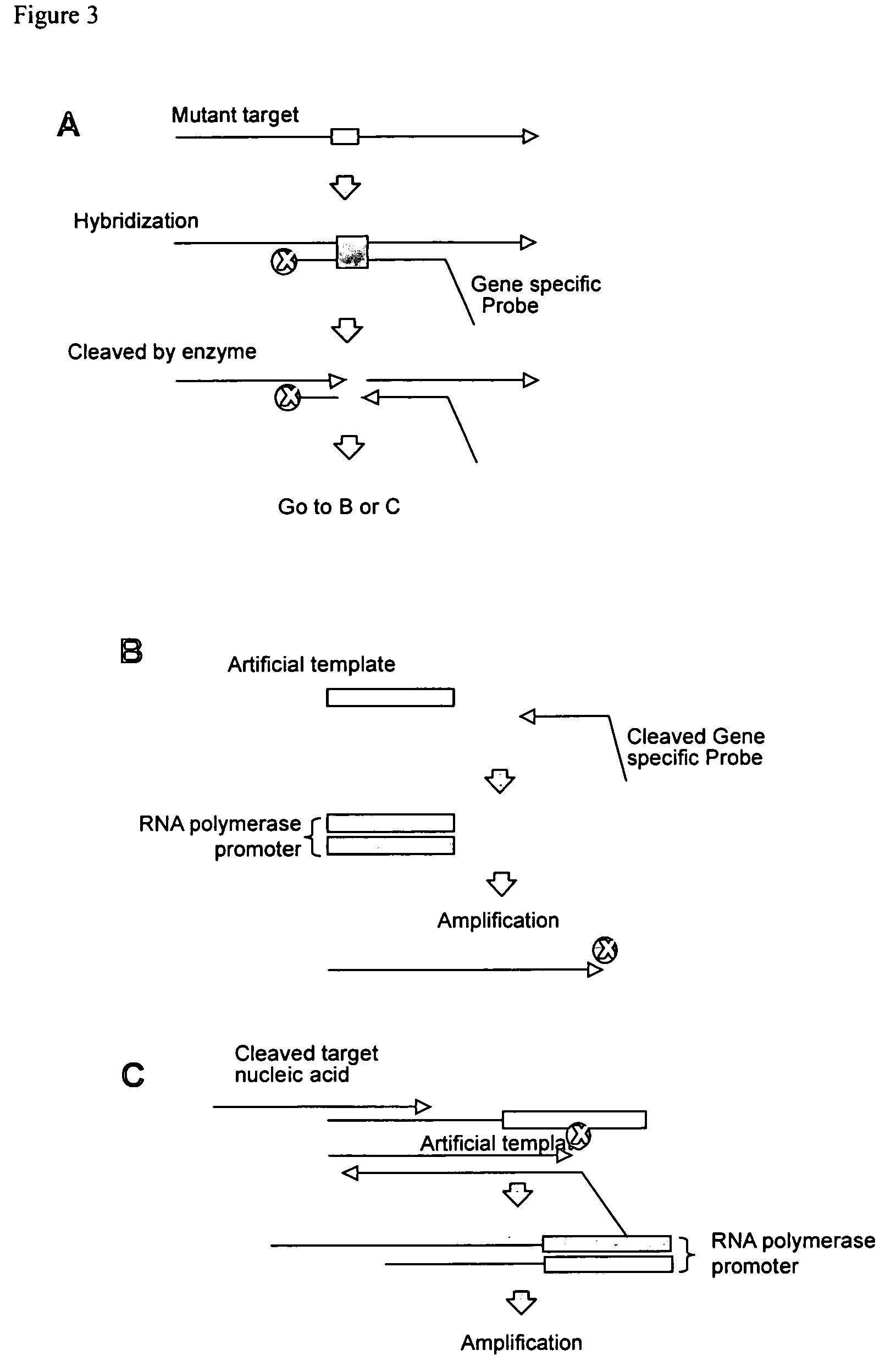Detection of nucleic acid variation by cleavage-amplification (CleavAmp) method
- Summary
- Abstract
- Description
- Claims
- Application Information
AI Technical Summary
Benefits of technology
Problems solved by technology
Method used
Image
Examples
embodiments
[0036] One embodiment provides a method for detecting a polymorphism in a polynucleotide. The method includes annealing a probe to a polynucleotide to a region of the polynucleotide suspected of containing a polymorphism to form a complex, wherein the probe comprises a non-extendable 3′ end and is not complementary to the polymorphism. Generally, the probe anneals to the polynucleotide so that the polymorphism is between the 3′ and the 5′ end of the probe. The polymorphism can be 1, 2, 3, 4, 5, 6, or more consecutive or non-consecutive nucleotides. When the probe anneals to a polynucleotide having a polymorphism, a variation structure or a mismatch structure is produced. The structure can be a bulge, loop, or other configuration resulting from the mismatch of nucleotides between the probe and the polymorphism.
[0037] The method further includes contacting the complex with an enzyme or chemical that cleaves the probe and the polynucleotide at a region of mismatch between the probe an...
example 1
[0056] Identification of the K-ras point mutation in codon 12 (GGT>GAT)
[0057] The K-ras mutation in codon 12 (GGT>GAT) creates a new restriction enzyme site for BccI. To detect the mutation, a probe complementary to the flanking sequence at both side of the mutation is designed for the cleavage and amplification.
[0058] The Non-Extendable Gene Specific Probe
(SEQ ID NO: 1)5′-TGTTCTTGTTTATTCGACACAGTTCTTCATAAACTTGTGGTAGTTGGAGCTGATGGTTT*
*is inverted dTTP
[0059] The Artificial Template
(SEQ ID NO: 2)5′-CTTGTTCTTGTTTATTCGACACAGTTCTTC GCTTTGGCCGCCGCCCAGTC CTGCTCGCTT CGCTACTTGG AGCCACTATCGACTACGCGA TCATGGCGAC CACACCCGTC CTGTGGATCCTCTACGCCGG ACGCATCGTG GCTCCAACTACCACAAGTTTATCCGAAA*.
*is ddATP
[0060] The Adapter Primer
CTTGTTTATTCGACACAGTTCTTC(SEQUENCE ID NO: 3)
The DNA Samples
[0061] The wild type genome DNA is purchased from Promega and Mutant DNA was extracted from human pancreas adenocarcinoma cells from ATCC (#CRL-2547) by using commercial DNA extraction kit (Qiagen). The final conce...
example 2
Identification of the B-raf Mutation in Codon 599 (GTG>GAG)
[0067] The B-raf mutation in codon 599 (GTG>GAG) does not created a new site for a restriction enzyme. To detect the mutation, a complementary probe with wild type sequence is designed to hybridize and form a mismatch structure with mutant allele. The probe will be cleaved at the mismatch position by a mismatch cleavage enzyme. The cleaved probe will serve as a primer for PCR amplification.
[0068] The Non-Extendable Gene Specific Probe
(SEQ ID NO: 4)5′-GTTCTTGTTTATTCGACACAGTTCTTCGGTGATTTTGGTCTAGCTACAGTGAAATCTC*A*G*T*T*T**
*is a nucleotide base with thiol modifier
**is inverted dTTP.
[0069] The Artificial Template
(SEQ ID NO: 5)5′-CTTGTTCTTGTTTATTCGACACAGTTCTTC GCTTTGGCCGCCGCCCAGTC CTGCTCGCTT CGCTACTTGG AGCCACTATCGACTACGCGA TCATGGCGAC CACACCCGTC CTGTGGATCCTCTACGCCGG ACGCATCGTG CATTTCACTGTAGCTAGACCAAAATCACCTTTT*
*is ddTTP
The DNA Template
[0070] Genomic DNA is prepared from thyroid cancer cell line as described in the J. Cl...
PUM
| Property | Measurement | Unit |
|---|---|---|
| Mass | aaaaa | aaaaa |
| Mass | aaaaa | aaaaa |
| Mass | aaaaa | aaaaa |
Abstract
Description
Claims
Application Information
 Login to View More
Login to View More - R&D
- Intellectual Property
- Life Sciences
- Materials
- Tech Scout
- Unparalleled Data Quality
- Higher Quality Content
- 60% Fewer Hallucinations
Browse by: Latest US Patents, China's latest patents, Technical Efficacy Thesaurus, Application Domain, Technology Topic, Popular Technical Reports.
© 2025 PatSnap. All rights reserved.Legal|Privacy policy|Modern Slavery Act Transparency Statement|Sitemap|About US| Contact US: help@patsnap.com



